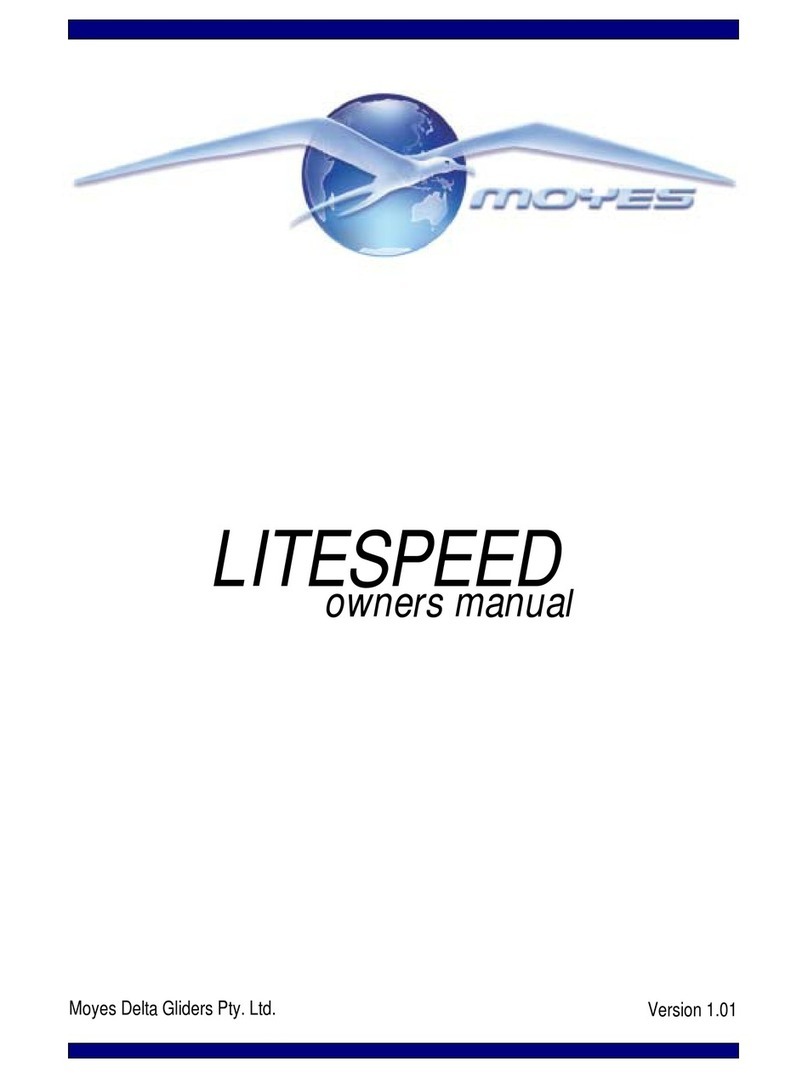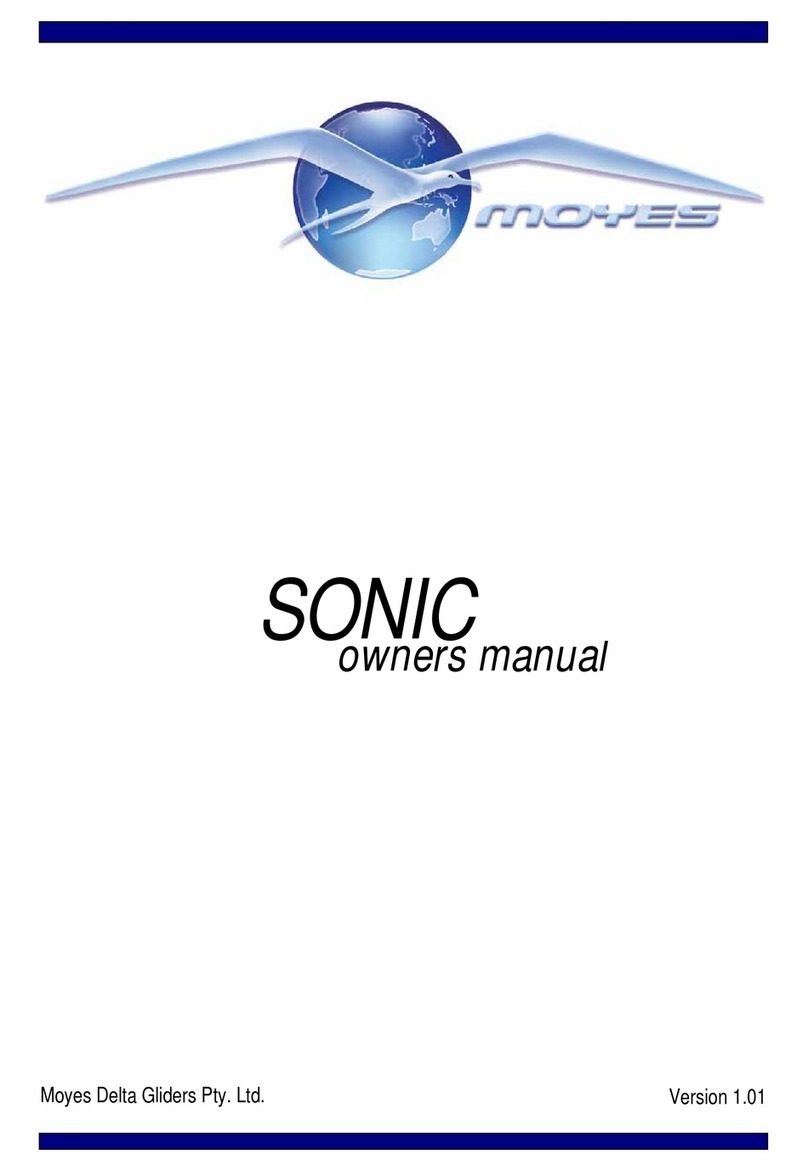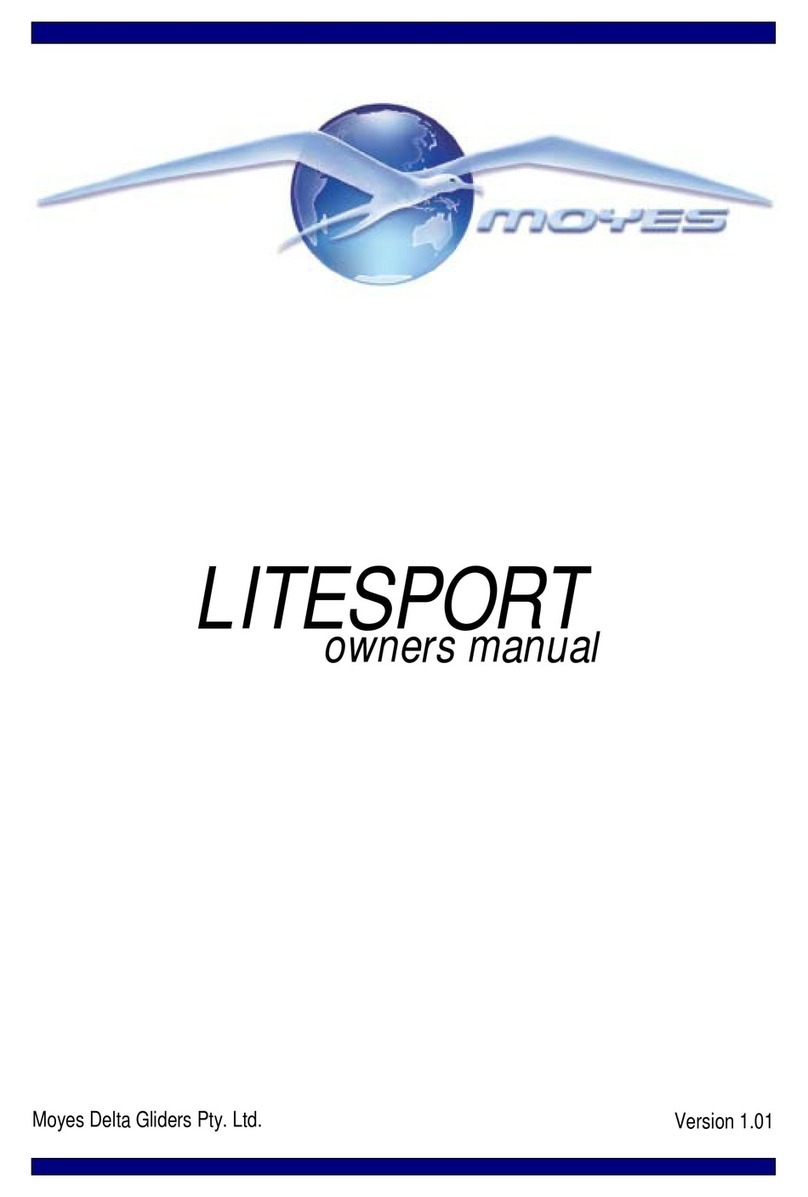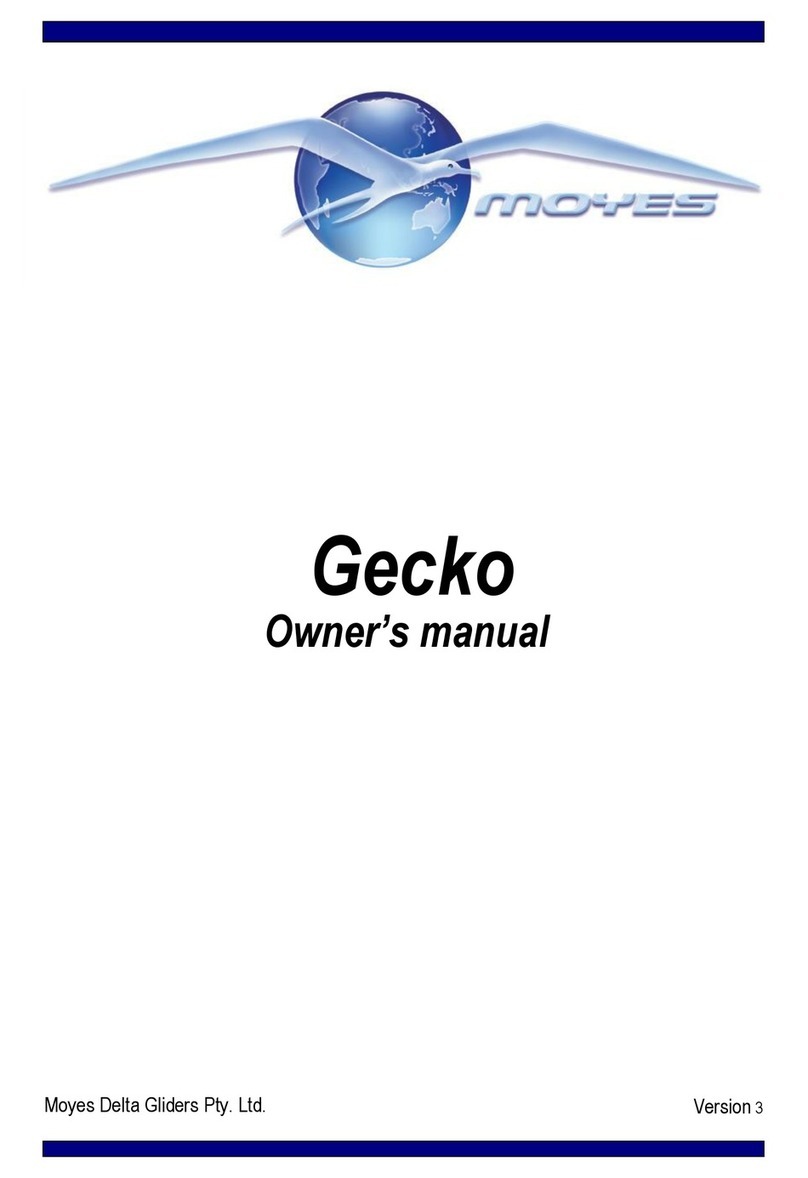moyes Conar HG16 User manual


Conar
HANGGLIDING EMERGENCY PARACHUTE
Model Gores [n°] Weight [kg] Area [m2]
Conar HG16 16 1,68 22,36
Conar HG18 18 2,02 28,38
Conar HG20 20 2.58 35,11
Conar HG22 22 3.12 42,54
Congratulations for choosing an outstanding
product. The name ‘Conar’ comes from ‘Cono
ApicaleRientrante’ the Italian for ‘Reverse Apex
Cone’; this patented design gives extraordinary
performance to this rescue parachute.
IDENTIFICATION
The hangglider Conar has a black
eye at the end of the bridle, next to the
manufacturing information (date, model, size).
INTRODUCTION
The hangglider Conar rescue parachute is only suitable for
hanggliding; its design makes it unsuitable for any other purpose including Para
Gliding, Free Fall and Base Jumping.
In our opinion hangglider reserves need to be designed to open very quickly, even
at low descent speed, for two main reasons: pilots often fly close to the ground
and ridge rotor turbulence is a major cause of tumbling. Moreover, even if the
accident happens with some altitude, hangglider pilots may lose time trying to
throw the rescue with a broken hangglider.
FAST OPENING: to obtain fast opening times at low speeds while maintaining a
low sink rate, we used these design criteria:
a - Reduced Surface:under the same conditions a smaller parachute has a faster
opening time.
b - Low Weight:the throw is easier and the lines unfold faster; the reduced
inertia also helps the canopy to open quickly even at very low airspeeds.
c - Pulled Down Apex: increases the lift coefficient to compensate the reduced
surface and reduces the opening time.
2

d - Reverse Apex Cone: -
Conar patent – it increases
stability, further reduces
sink-rate by 20%, impact
energy by 40% and, on
average, opening time by
almost 10%.
The fabric cone inside the
Conar Apex forces airflow
alongside the cone and
then through a narrow slot.
The airflow is accelerated
over the upper surface
creating a “Venturi Effect”
which makes lift.
e - Packing system:the Conar has a very fast and reliable deployment. The
opening sequence is controlled by the packing (which is why the Conar must be
packed according to this owner manual). To avoid malfunctions the canopy
deploys in a strict order: first the central wind channel opens quickly and the folded
canopy corners open next. This is so efficient that once the lines are extended, the
canopy opens completely in just a few meters travel.
RELIABILITY: the fast and reliable opening of the Conar relies on the correct
opening sequence of “bridle-lines-canopy”. To reduce the risk of lines tangling or
releasing prematurely they are contained in a separate compartments of the
deployment bag with a light nylon sock holding the lower lines (which slides down
or splits on deployment). To reduce the chance of a line getting tangled there
needs to be a long bridle while to get a better sink-rate and stability there needs to
be long line, but to have a fast opening the sum of line plus bridle should be short.
The “line-bridle” resolves this problem by increasing the length of the bridle only
when is needed both reducing the chance of a line getting tangled and allowing a
faster opening time. The Conar bridle is made of braided Nylon®HT to better
withstand opening shock and possible damages due to the glider wreckages
during opening.
STRUCTURAL RESISTANCE: the Conar is a very strong, light parachute
system designed specifically for hanggliders. The Conar uses many sophisticated
materials including High Tenacity, low porosity parachute grade fabric, Kevlar®29
seam reinforcements and Nylon®HT lines and bridle for better energy absorption.
However, the Conar emergency parachute is not suitable for free fall terminal
speed(an unlikely situation while hanggliding if using proper hang straps). Free
fall parachutes operate at very high vertical speeds so the opening sequence is
delayed to reduce the opening shock. If the Conar were optimised for free fall use
it would not operate satisfactorily in hanggliding emergencies.
EXTRACTION: The Conar emergency parachute will fit a standard harness container.
3

AGEING: synthetic materials deteriorate with age, particularly after exposure to
sun and moisture. The Conar has been designed with UV protection by making
the protective bridle sheath and the optional outer containers from black-coated
fabric; also, the parachute is covered with an aluminium UV protection sheet.
However total UV protection is impossible and we recommend that the
parachute be inspected by the manufacturer periodically for premature ageing.
- - CAUTION - -
A parachute has a maximum lifespan even if it is carefully
maintained. The materials age invisibly and after 10 years it will not
be completely reliable and should be replaced.
A – Canopy E – Pull down apex lines
B – Leading Edge F – Suspension lines sock
C – Reverse Apex Cone G – Bridle
D – Suspension Lines H – Sheath bridle
4

OPERATING INSTRUCTIONS
Mount your Conarparachute into your harness according to the instructions of the
harness manufacturer. If possible use the original Conar handle. If you
have to use the handle that comes with the harness, attach it to the small loop in
the deployment bag. Remember that a long handle makes throwing difficult and
the risk of tangling increases.
The handle must not have Velcro hookssewn on because they could stick to the
lines and prevent the deployment bag from opening.
It is important to ensure the handle can be seen during flight, and be very easy to
grasp,with your thumb, in any situation.
After each repack it is mandatory to check the extraction while hanging in
yourharness:itis no use having agood parachute if you cannotget it out!
SINK RATE CALCULATION
Use this formula to calculate the height of a jump equivalent to your sink rate
under canopy.
- valid for Conar parachutes only -
meters = 4 x weight / gores2
Example: 80 kg hook in weight (if using a rigid wing add half of the wing weight)
and using a Conar PG16
Eq. height = 4 x 80 / (16x16) = 1.25 m
For this pilot, landing under a Conar HG16 parachute will be the same as jumping
down from 1.25 m (approximately 5 m/s).
It’s important to choose the correct compromise between opening time and sink
rate:
-a smaller parachute will open faster but its sink rate may be too high and
you may hurt yourself.
-if your parachute is too big the landing will be smoother but, if you are too
low, the parachute might not open in time
With the Conar there is no need to trade sink rate for opening time: the best
compromise is equivalent to a jump from 1.30 m, a sink rate that is perfectly
acceptable for the average pilot. The maximum “equivalent height” for a fit athletic
pilot is about 1.80 m and, excluding special cases, we suggest not to go below
1.00 m.
Choose the equivalent height which is acceptable for you considering your age
and fitness conditions.
5
This manual suits for next models
3
Table of contents
Other moyes Aircraft manuals
























